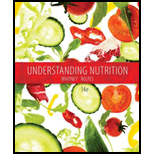
Understanding Nutrition
14th Edition
ISBN: 9781285874340
Author: Eleanor Noss Whitney, Sharon Rady Rolfes
Publisher: Cengage Learning
expand_more
expand_more
format_list_bulleted
Concept explainers
Question
Chapter 15, Problem 1BCTQ
Summary Introduction
To explain: The difficulties that researchers encounter in trying to determine the exact amount of alcohol and the timing during pregnancy that might be reasonably safe for fetal development.
Concept introduction: Drinking alcohol during pregnancy can cause serious health problems to the fetus. When alcohol is consumed, it passes through the placenta and the umbilical cord to the fetus. This affects the development of the central nervous system and other organs of fetus.
Expert Solution & Answer
Want to see the full answer?
Check out a sample textbook solution
Chapter 15 Solutions
Understanding Nutrition
Knowledge Booster
Learn more about
Need a deep-dive on the concept behind this application? Look no further. Learn more about this topic, health-nutrition and related others by exploring similar questions and additional content below.Similar questions
- ________ Although the incidence of neural tube defects in the United States declined post-folic acid fortification, some women are still at risk. Which of the following options represents a risk group for inadequate folate status and a neural tube defect affected pregnancy? a. Non-Hispanic Black women b. Non-Hispanic White women c. Asian Americans d. Hispanic Americansarrow_forwardNutrient and waste requirements for the developing fetus are handled during the first few weeks by _____. a. the placenta b. diffusion through the endometrium c. the chorion d. the blastocystarrow_forwardDescribe the stages of labor.arrow_forward
- Define and describe the main features of the following developmental stages: fertilization, cleavage, gastrulation.arrow_forwardJan is concerned about using ART. She wants to be the genetic mother and have Darryl be the genetic father of any children they have. What methods of ART would you recommend to this couple? Jan, a 32-year-old woman, and her husband, Darryl, have been married for 7 years. They have attempted to have a baby on several occasions. Five years ago, they had a first-trimester miscarriage, followed by an ectopic pregnancy later the same year. Jan continued to see her OB/GYN physician for infertility problems but was very dissatisfied with the response. After four miscarriages, she went to see a fertility specialist, who diagnosed her with severe endometriosis and polycystic ovarian disease (detected by hormone studies). The infertility physician explained that these two conditions were hampering her ability to become pregnant and thus making her infertile. She referred Jan to a genetic counselor. At the appointment, the counselor explained to Jan that one form of endometriosis (MIM 131200) can be a genetic disorder, and that polycystic ovarian disease can also be a genetic disorder (MIM 184700) and is one of the most common reproductive disorders among women. The counselor recommended that a detailed family history of both Jan and Darryl would help establish whether Jans problems have a genetic component and whether any of her potential daughters would be at risk for one or both of these disorders. In the meantime, Jan is taking hormones, and she and Darryl are considering alternative modes of reproduction. Using the information in Figure 16.4, explain the reproductive options that are open to Jan and Darryl.arrow_forwardThe complications of ectopic pregnancy (Section 17.2) are life-threatening for the mother, and in fact each year in the United States a few pregnant women die when their situation is not diagnosed in time. Tragically, the only option is to surgically remove the embryo, which was doomed from the beginning. Based on what you know about where an embryo normally develops, explain why the ectopic embryo in Figure 17.25 could not have long survived. Figure 17.25 This embryo, the result of an ectopic pregnancy, could not survive implantation outside its mothers uterus.arrow_forward
arrow_back_ios
arrow_forward_ios
Recommended textbooks for you
 Nutrition Through The Life CycleHealth & NutritionISBN:9781337919333Author:Brown, Judith E.Publisher:Cengage Learning,
Nutrition Through The Life CycleHealth & NutritionISBN:9781337919333Author:Brown, Judith E.Publisher:Cengage Learning, Human Biology (MindTap Course List)BiologyISBN:9781305112100Author:Cecie Starr, Beverly McMillanPublisher:Cengage Learning
Human Biology (MindTap Course List)BiologyISBN:9781305112100Author:Cecie Starr, Beverly McMillanPublisher:Cengage Learning Microbiology for Surgical Technologists (MindTap ...BiologyISBN:9781111306663Author:Margaret Rodriguez, Paul PricePublisher:Cengage Learning
Microbiology for Surgical Technologists (MindTap ...BiologyISBN:9781111306663Author:Margaret Rodriguez, Paul PricePublisher:Cengage Learning

Nutrition Through The Life Cycle
Health & Nutrition
ISBN:9781337919333
Author:Brown, Judith E.
Publisher:Cengage Learning,




Human Biology (MindTap Course List)
Biology
ISBN:9781305112100
Author:Cecie Starr, Beverly McMillan
Publisher:Cengage Learning

Microbiology for Surgical Technologists (MindTap ...
Biology
ISBN:9781111306663
Author:Margaret Rodriguez, Paul Price
Publisher:Cengage Learning